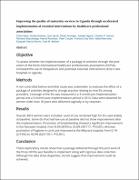| dc.identifier.citation | Spira, C., Kwizera, A., Jacob, S., Amongin, D., Ngonzi, J., Namisi, C.P., Byaruhanga, R., Rushwan, H., Cooper, P., Day‐Stirk, F. and Berrueta, M., 2017. Improving the quality of maternity services in Uganda through accelerated implementation of essential interventions by healthcare professional associations. International Journal of Gynecology & Obstetrics, 139(1), pp.107-113. | en_US |
| dc.description.abstract | Objective
To assess whether the implementation of a package of activities through the joint action of the three international healthcare professionals associations (HCPAs) increased the use of intrapartum and postnatal essential interventions (EIs) in two hospitals in Uganda.
Methods
A non‐controlled before‐and‐after study was undertaken to evaluate the effect of a package of activities designed to change practice relating to nine EIs among providers. Coverage of the EIs was measured in a 3‐month pre‐implementation period and a 3‐month post‐implementation period in 2014. Data were obtained for women older than 18 years who delivered vaginally or by cesarean.
Results
Overall, 4816 women were included. Level of use remained high for EIs used widely at baseline. Some EIs that had low use at baseline did not show improvement after the implementation. Promotion of breastfeeding showed a significant improvement in the Kampala hospital, from 8.5% (8/94) to 25.6% (30/117; P=0.001), whereas promotion of hygiene in cord care improved at the Mbarara hospital, from 0.1% (2/1592) to 46.0% (622/1351; P<0.001).
Conclusion
These exploratory results show that a package delivered through the joint work of the three HCPAs was feasible to implement along with rigorous data collection. Although the data show disparities, trends suggest that improvement could be achieved. | en_US |


